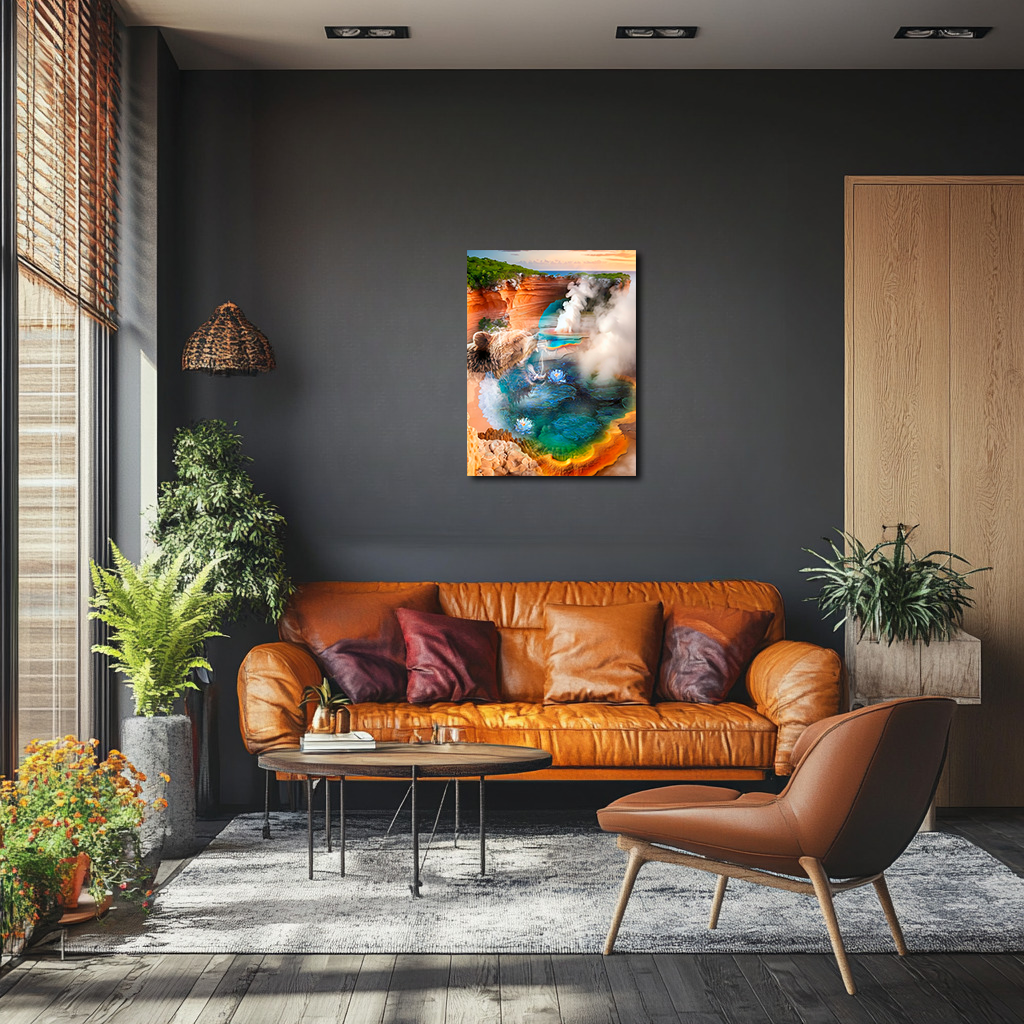Breath of the Earth: Water Lilies Reimagined in Elemental Dream
Breath of the Earth: Water Lilies Reimagined in Elemental Dream transforms Monet’s peaceful pond into a geothermal vision where water, memory, and spirit converge. Framed by mineral cliffs and clouds of sacred mist, the iconic lilies now float in a volcanic spring, blooming beside a dreamlike figure and a guardian bear breathing wind into the scene. This conceptual reimagining fuses Monet’s impressionistic softness with elemental power, offering a surreal meditation on earth’s breath, the wildness of memory, and the sacred stillness found within color, water, and flame.
Please see Below for Details…
Hotline Order:
Mon - Fri: 07AM - 06PM
404-872-4663
Claude Monet’s Water Lilies , painted in the later years of his life between 1914 and 1926, remains one of the most transcendent series in the history of Impressionism. It was a meditation on nature, reflection, stillness, and the threshold between light and water. The original canvas at the Metropolitan Museum of Art presents a serene pool dotted with water lilies, their petals floating weightlessly in a mirrored surface that defies horizon or edge. In this conceptual reinterpretation, titled Breath of the Earth: Water Lilies Reimagined in Elemental Dream , the pond has ruptured into a geothermal bloom, a spiritual landscape forged from the fire of the planet and the dreamscape of the soul.
The tranquil lily pond no longer rests in a secluded garden. It has emerged from the center of the earth, blooming out of a vast geothermal spring, its edges rippling in radiant hues—burnt orange, emerald, turquoise, and volcanic gold. The colors are not just vibrant. They are alive. They pulse like veins through stone, carved from time and temperature, their contours glowing with ancient memory. The pool swells upward from the canyon, as if the painting itself were born from tectonic awakening.
At the heart of the spring, Monet’s water lilies still float—but now they drift across waters shaped by the mineral breath of the planet. They are scattered not randomly but with compositional grace, appearing as both memory and offering. Each bloom sits upon the surface of churning color as a point of meditation, a stillness in a swirling world.
Rising from the mist is the central figure of the reinterpretation—a woman submerged in dreamlike gesture, her arms outstretched, her face turned upward in suspended exhalation. She is neither fully real nor entirely spirit. Her form is fluid, as if she belongs more to water than to skin. Her presence evokes Monet’s desire to remove the boundary between viewer and nature. She does not pose. She emerges. Her placement at the center of the pool creates a living symmetry, a point of focus and release, where consciousness merges with color.
To the left, a massive bear breathes toward the pool, eyes closed, as if offering the wind of memory or prayer. The bear is not wild nor threatening. It is maternal, wise, ancestral. Its breath connects the animal world to the thermal breath of the earth, completing the cycle of spirit, nature, and breath. The composition suggests that the bear’s exhalation may be what creates the mist, what stirs the water, what calls forth the lilies. The creature becomes both guardian and guide, instinctual and deeply knowing.
Above, the landscape opens to a carved canyon rim, bathed in golden sunlight. The juxtaposition of the mineral cliffs with the soft forest beyond creates a balance between fire and rest, heat and hush. The land feels ancient and newly discovered all at once. The canyon’s walls, like pages from the earth’s journal, stretch outward to form the cradle of the vision, a geological cathedral for the unfolding dream.
Clouds of vapor rise from the spring, blurring time and place. In Monet’s work, mist was always a veil of mystery—a softening of certainty. Here, mist becomes more than atmosphere. It becomes breath, a living force. It twists upward as a sacred offering, a reminder that the earth, like us, is always exhaling stories we are still learning how to read.
Color is essential in this piece. Monet’s original palette was layered with cool tones—blues, purples, greens—inviting meditation. This reinterpretation intensifies those hues while grounding them in the warmest ends of the spectrum—reds, ambers, volcanic ochres. The result is a colorfield that speaks not only of contemplation, but of emergence. It does not simply invite the viewer to observe. It asks them to listen, to stand in the heat and steam, to inhale what it means to remember the world before words.
As the artist, I approached this work not only as homage but as invocation. Monet painted the surface of water as an emotional mirror. I sought to reinterpret it as a mythological spring—one that holds memory not just of light but of the earth’s awakening. In this version, the lilies are sacred offerings. The woman is not a muse but a spirit of the water, a symbol of connection between breath, body, and source. The bear, guardian of the passage, reminds us that we are never apart from the wild, only momentarily forgetful of its presence within us.
Add your review
Your email address will not be published. Required fields are marked *
Please login to write review!
Looks like there are no reviews yet.








